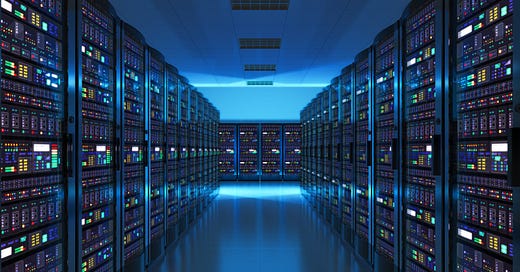The Digital Fortress: Data Centers
The world of data centers: What they are, How they’re built, and Why they’re essential to the digital age.
Hey friends,
This week, let’s talk about data centers!
Image Credit: Rack Solutions
Data centers are the hidden giants of the internet. Everything on the internet is powered by rows upon rows of humming servers sitting inside massive, climate-controlled warehouses. I like to think of them like this: the internet is the invisible web, whereas a data center is the tangible building. Without data centers, the digital world as we know it simply wouldn’t exist.
So, What Is a Data Center?
At its core, a data center is simply the physical facility used to house computer systems and associated components like servers, storage systems, and networking equipment. These centers process, store, and distribute the data behind everything from websites to financial transactions!
Most data centers are strategically built for redundancy and security of the information, which is obviously critical. Many are also fortified with biometric scanners and 24/7 surveillance because the stakes-corporate data, financial systems, national infrastructure-are that just high!
Building one isn’t cheap…
Constructing a modern data center is a huge project. A single large-scale facility can cost upwards of $1 billion to build and equip.
Location matters too. they’re usually placed where electricity is cheap, fiber-optic infrastructure is robust, and climate conditions allow for efficient cooling.
Power and cooling are two of the biggest challenges. Servers generate a lot of heat. So much, in fact, that cooling can make up nearly 40% of a data center's total energy consumption. This is one reason why companies like Microsoft and Google have experimented with underwater data centers and AI-optimized cooling solutions!
Artificial Intelligence…
AI is rapidly becoming the brain of the data center. It’s changing everything from operations to security, and its impact is only growing.
By learning patterns from past data, AI can now anticipate equipment failures before they happen. This means fewer outages and reduced maintenance costs. McKinsey & Company found that AI-driven predictive maintenance has cut costs for some companies by up to 25%!
Energy efficiency is also another major win. Google used AI to cut its data center cooling bill by 40%. That’s not just money saved—it’s a big step toward reducing the environmental impact of our digital infrastructure.
AI also improves workload management. Modern applications, especially generative AI tools like ChatGPT, demand massive computational power. Forecasts predict that training and running generative AI models will cost $76 billion by 2028! That’s more than double Amazon Web Services' yearly tab.
In the cybersecurity arena as well, AI is a game-changer. By constantly analyzing network traffic and behavior, it can detect and block suspicious activity faster than most traditional systems.
All in all, data centers are the HQs of our digital lives. And with AI now embedded in their DNA, they're becoming faster, smarter, and more efficient.
That’s all for this week!
Keep learning,
Suhana.




